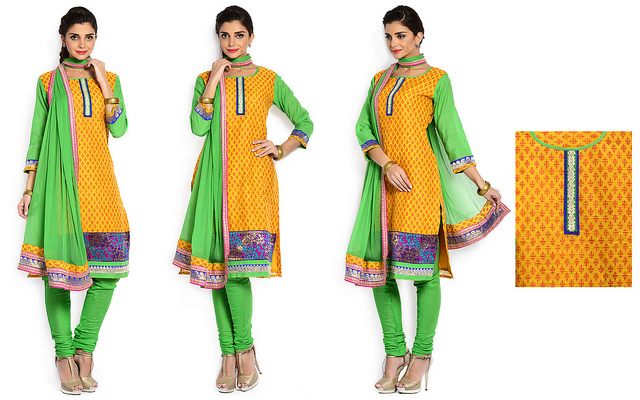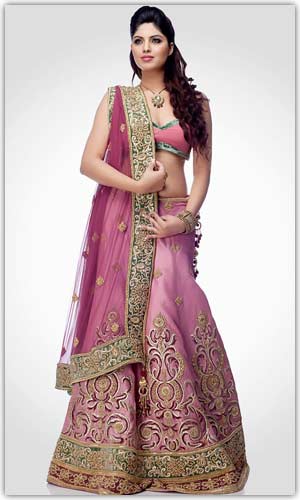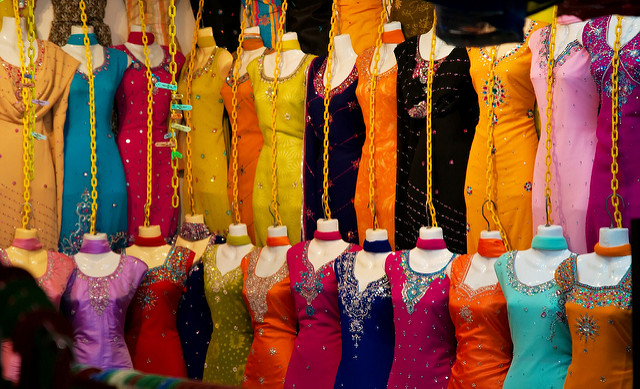Shopping Adventures in India Posted by Rachael on May 6, 2018 in Uncategorized
Like finding suitable transportation, finding and buying clothing in India has its own challenges. One of the great things about visiting and/or living in India is that you can choose your own material and buy clothes that are custom-fitted to you by working with a clothing vendor and tailor. Of course, malls are also an option, yet here all of the merchandise is fixed-price and is not fitted to your exact specifications. So, if you’d like to try shopping for clothes the “old-fashioned” way––choosing your own fabric, style and fit––pay attention to my helpful tips below!
कपड़े की अच्छी दुकान चुनना / Kapare ki acchi dukaan chunna : Choosing a Good Fabric Store
If you’re new in town (or in the country, for that matter), I would try asking locals which fabric stores they prefer. Word of mouth can be a very powerful tool in terms of obtaining recommendations for fair vendors who stock high-quality cloth.
If you are “hustled” to a fabric store in any way (that is, tricked into going to a store by a rickshaw driver, local guide or other individual who has been paid a commission to take you there), you can go ahead and cross that store off your list. Even if you wanted to buy something there, the prices would most likely be grossly inflated, the merchandise low quality and the salesmen pushy and rude. Another note is to stay away from areas that receive high tourist traffic––the prices here are DEFINITELY inflated and the salesmen know they can demand such prices because the people who frequent these areas are ignorant of standard prices and local cultural norms. So, a convenient boutique store near the Hawa Mahal (हवा महल, a historical monument in Jaipur), for example, is a definite no-no. Another tip-off is a salesman who lures you into his shop from an inappropriate place (like the sidewalk), is very pushy and demands split-second decisions on your part. A store with high quality cloth doesn’t need such inappropriate sales tactics because the employees who work there know that the high quality of the merchandise they sell will speak for itself.
One such place I would recommend is खादी घर/Khaadi Ghar/Cotton House (or Emporium) in Jaipur-–the cloth is reasonably priced, considering the high quality, and it is fixed price, so no bargaining is necessary. The employees are helpful and courteous and the cloth they sell, most of which is made of high-quality cotton (hence the name) comes in a variety of colors and muted patterns to suit individual tastes. If you’re looking for something flashy, this isn’t the place to go––most of the cloth is hand-died in organic colors and does not feature a lot of baubles.
दुकान में मोल-तोल करना / Dukaan me mol-tol karnaa : Bargaining in the Store
In fabric stores where bargaining is the norm (that is, most of them), you should ask around before visiting the shop about what locals pay. As a first-timer (and a foreigner) in the shop, you will most likely not be able to pay the local price. But, you can get the price down if you decide beforehand what your price threshold is and remain adamant that you will not pay over that. Walking out of the store, especially when the salesmen are being pushy and overly demanding, usually works to lower the price. However, this is not a good strategy if you want to form a relationship with the salespeople and hope to get better prices in the future.
If you walk into a fabric store and decide you would like to come back here as a regular in the future, you should engage in “gentle but firm” negotiation: “मैं इस से ज़्यादा नहीं दे सकता/सकती,” (I can’t pay over X amount) “मैं छात्र हूँ, मेरे पास बहुत ज़्यादा पैसा नहीं है,” (I’m a student, I don’t have a lot of money––may not apply to you!) “मुझे लगता है कि आप थोड़ा ज़्यादा माँग रहे हैं,” (It seems to me that you are asking for a bit too much)––such phrases may serve you well in your efforts to become a better bargainer. If you end up paying 50 to 100 rupees more than what you wanted to the first time, it’s no big deal, because, as a repeat customer, you will getter better prices if the salespeople want to keep your business.
A common custom in shops, both reputable and disreputable, is to offer a customer who has just walked in a “गरम चाय/garam chaay” (hot spiced tea with milk) or “कोल्ड ड्रिंक/cold drink” (that is, soda)––it’s fine and considered polite to accept, but just know this is a sales tactic to make you feel beholden to the salespeople who went out of their way to get you a refreshment so that you will feel pressured to buy. If the prices are too high and/or the fabric looks cheap, don’t feel pressured, just say thank you and walk away.
बढ़िया दर्ज़ी को ढूँढना / Bariya darzi ko dundhnaa : Finding an Excellent Tailor
Some fabric stores will have an in-house tailor who will measure you, cut the cloth and sew the clothing for you, in which case you would have to negotiate the price of the cloth + tailoring fees together, but most don’t. Much of the time, after you purchase the fabric, you will have to find your own tailor. Some fabric stores will try to recommend a tailor to you and give you his card, in which case you can assume that the fabric store and the tailor have an arrangement between them in which money is most likely being exchanged to increase the business of both parties. Nothing is wrong with this, but I wouldn’t assume that, just because the fabric store recommended the tailor to you, he is skilled and efficient at his job. The use of the pronoun “he” is not a mistake here as most tailors and salespeople at fabric stores are men, especially in North India.
I would try asking neighbors and acquaintances who they would recommend as a good tailor, but be aware that a highly in-demand tailor will expect you to wait for his services. For example, once my host family recommended a tailor to me whom they employed for most of their sewing work––in addition to the lag associated with “Indian Standard Time/IST,” he was also busy and in-demand, so he arrived about 2 hours later to our scheduled appointment and was rude and overpriced to top it off. It’s best not to get into a situation like that––if your host family suggests a person whom you will pay for his/her services and that person treats you badly, you will be stuck paying them inflated prices, dealing with his/her bad attitude and perhaps hiring them in the future because not to do so would offend the family with whom you’re staying.
A similar situation happened to me with a regular rickshaw wallah (रिक्शावाला/rickshaw driver) whom my family hired to take me to school each day and who was also a “family friend.” His rude, surly attitude and high prices despite steady employment were anathema to me, but when I suggested getting a different rickshaw wallah, my host family was very offended and told me I could not “fire” him by any means. Take my advice––avoid these types of “conflict of interest” situations as if they’re the plague.
To return to the topic at hand: once you find a good tailor––and much of the time they work in a particular area of the city, sometimes “conveniently” across the street from many fabric stores––he will have to measure you (which can get uncomfortable if the person is not professional; in the event you feel you’ve wandered into a sticky situation, make an excuse and get out of there), you’ll have to tell him the specifications of what you want (neck line, sleeve style and pant style, if you’re getting a full outfit) and return a couple of days later to pick up the completed outfit. Of course, if all of this sounds a bit too tiring (as it would to most Americans used to buying ready-made, fixed price clothing online or in a department store), you can take a day off and just go to the mall.
Below is a table of terms I hope will prove helpful in your shopping adventures:
| Hindi Word | Roman Transliteration | Definition |
|---|---|---|
| कुरता (masc. noun) | Kurtaa | A long tunic that extends anywhere from several inches below the waist to below the knees, for men and women. |
| कुरती (fem. noun) | Kurtee | A short tunic that usually ends at the waist (primarily for women). |
| खादी (fem. noun) | Khaadi | Cotton |
| चुड़़ीदार (masc. noun) | Chureedaar | Tight-fitting pants with a drawstring at the waist and bunches near the ankles that look like bangles on someone's wrist, hence the name (चुड़ी/churi=a bangle). For men and women. |
| दर्ज़ी (fem. noun) | Darzi | Tailor (as in, the profession) |
| दुपट्टा (masc. noun) or चुन्नी (fem. noun) | Dupatta, chunni | A stole or scarf that traditionally drapes across the chest but can be worn on the shoulder, draped over the head and across the shoulders and in other ways as well, for women. |
| नापना (verb) | Naapnaa | To measure |
| रेशम (masc. noun), रेशमी (adjective) | Resham, reshmi | Silk; silky, silken |
| लहंगा (masc. noun) | Lehengaa | A woman's outfit consisting of (usually) a midriff-bearing (चोली) or regular length top and a long, flowing skirt. |
| सलवार कमीज़ (fem. noun) | Salwaar kameez | A pairing of salwaar/सलवार or billowy pants with a drawstring at the waist (or sometimes churidaar, see below) and kameez/कमीज़, or a tunic of some kind, usually a kurtaa/कुरता. For men and women. |
| रूमाल (masc. noun) | Roomaal | A handkerchief made of cloth (for men and women). |
| चादर (fem. noun) | Chaadar | A shawl that one wraps around one's body (men and women); this term can also mean a bed sheet. Also sometimes just called a "शाल/shaal." |
| साड़ी (fem. noun) | Saari | A woman's outfit consisting of a short, fitted top (similar to that of a लहंगा/lehengaa, known as a चोली), a petticoat (not seen) and several yards of fabric which are wrapped around the body and draped over one shoulder. |
| चोली (fem. noun) | Choli | A short (usually midriff-bearing), fitted top that one wears typically with a sari/साड़ी or a लहंगा/lehengaa. |
| धोती (fem. noun) | Dhoti | Yards of cotton or silk fabric that are wrapped around the legs and waist to create a draped lower garment (for men). |
| घाघरा (masc. noun) | Ghaaghraa | A long, flowing skirt that women wear as part of a lehenga. |

Build vocabulary, practice pronunciation, and more with Transparent Language Online. Available anytime, anywhere, on any device.







